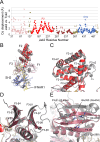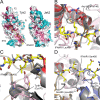Crystal Structure of the FERM-SH2 Module of Human Jak2
- PMID: 27227461
- PMCID: PMC4881981
- DOI: 10.1371/journal.pone.0156218
Crystal Structure of the FERM-SH2 Module of Human Jak2
Abstract
Jak-family tyrosine kinases mediate signaling from diverse cytokine receptors. Binding of Jaks to their cognate receptors is mediated by their N-terminal region, which contains FERM and SH2 domains. Here we describe the crystal structure of the FERM-SH2 region of Jak2 at 3.0Å resolution. The structure reveals that these domains and their flanking linker segments interact intimately to form an integrated structural module. The Jak2 FERM-SH2 structure closely resembles that recently described for Tyk2, another member of the Jak family. While the overall architecture and interdomain orientations are preserved between Jak2 and Tyk2, we identify residues in the putative receptor-binding groove that differ between the two and may contribute to the specificity of receptor recognition. Analysis of Jak mutations that are reported to disrupt receptor binding reveals that they lie in the hydrophobic core of the FERM domain, and are thus expected to compromise the structural integrity of the FERM-SH2 unit. Similarly, analysis of mutations in Jak3 that are associated with severe combined immunodeficiency suggests that they compromise Jak3 function by destabilizing the FERM-SH2 structure.
Conflict of interest statement
Figures






References
MeSH terms
Substances
Grants and funding
LinkOut - more resources
Full Text Sources
Other Literature Sources
Miscellaneous

